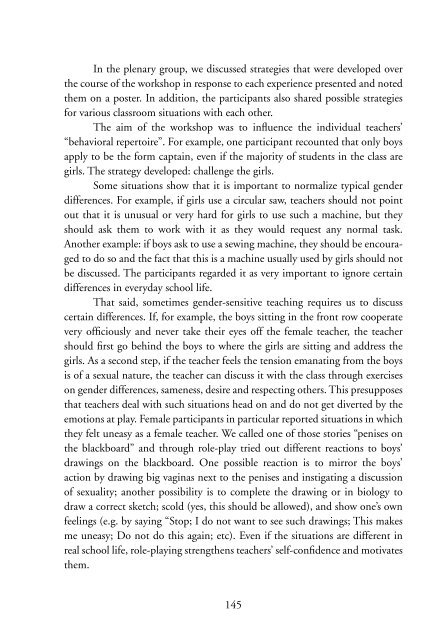Teaching with the third wave new feminists - MailChimp
Teaching with the third wave new feminists - MailChimp
Teaching with the third wave new feminists - MailChimp
Create successful ePaper yourself
Turn your PDF publications into a flip-book with our unique Google optimized e-Paper software.
In <strong>the</strong> plenary group, we discussed strategies that were developed over<strong>the</strong> course of <strong>the</strong> workshop in response to each experience presented and noted<strong>the</strong>m on a poster. In addition, <strong>the</strong> participants also shared possible strategiesfor various classroom situations <strong>with</strong> each o<strong>the</strong>r.The aim of <strong>the</strong> workshop was to influence <strong>the</strong> individual teachers’“behavioral repertoire”. For example, one participant recounted that only boysapply to be <strong>the</strong> form captain, even if <strong>the</strong> majority of students in <strong>the</strong> class aregirls. The strategy developed: challenge <strong>the</strong> girls.Some situations show that it is important to normalize typical genderdifferences. For example, if girls use a circular saw, teachers should not pointout that it is unusual or very hard for girls to use such a machine, but <strong>the</strong>yshould ask <strong>the</strong>m to work <strong>with</strong> it as <strong>the</strong>y would request any normal task.Ano<strong>the</strong>r example: if boys ask to use a sewing machine, <strong>the</strong>y should be encouragedto do so and <strong>the</strong> fact that this is a machine usually used by girls should notbe discussed. The participants regarded it as very important to ignore certaindifferences in everyday school life.That said, sometimes gender-sensitive teaching requires us to discusscertain differences. If, for example, <strong>the</strong> boys sitting in <strong>the</strong> front row cooperatevery officiously and never take <strong>the</strong>ir eyes off <strong>the</strong> female teacher, <strong>the</strong> teachershould first go behind <strong>the</strong> boys to where <strong>the</strong> girls are sitting and address <strong>the</strong>girls. As a second step, if <strong>the</strong> teacher feels <strong>the</strong> tension emanating from <strong>the</strong> boysis of a sexual nature, <strong>the</strong> teacher can discuss it <strong>with</strong> <strong>the</strong> class through exerciseson gender differences, sameness, desire and respecting o<strong>the</strong>rs. This presupposesthat teachers deal <strong>with</strong> such situations head on and do not get diverted by <strong>the</strong>emotions at play. Female participants in particular reported situations in which<strong>the</strong>y felt uneasy as a female teacher. We called one of those stories “penises on<strong>the</strong> blackboard” and through role-play tried out different reactions to boys’drawings on <strong>the</strong> blackboard. One possible reaction is to mirror <strong>the</strong> boys’action by drawing big vaginas next to <strong>the</strong> penises and instigating a discussionof sexuality; ano<strong>the</strong>r possibility is to complete <strong>the</strong> drawing or in biology todraw a correct sketch; scold (yes, this should be allowed), and show one’s ownfeelings (e.g. by saying “Stop; I do not want to see such drawings; This makesme uneasy; Do not do this again; etc). Even if <strong>the</strong> situations are different inreal school life, role-playing streng<strong>the</strong>ns teachers’ self-confidence and motivates<strong>the</strong>m.145
















